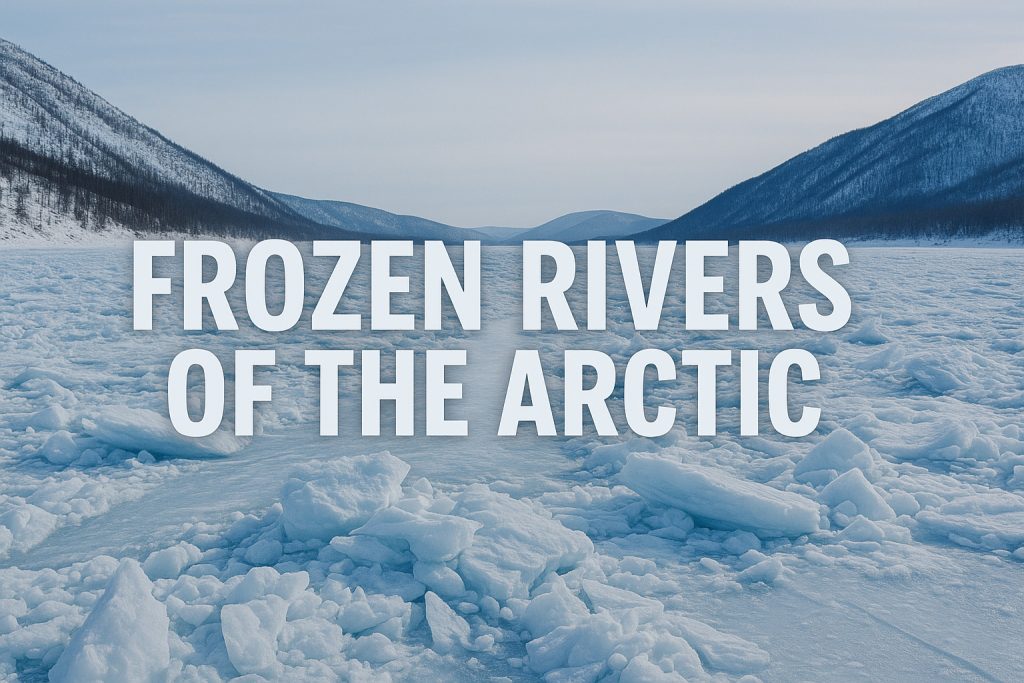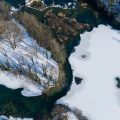Discover the frozen rivers of the Arctic – Yenisei, Ob, and Mackenzie. Explore how nature and people adapt to life on icy waters.
The frozen rivers of the Arctic are among the most extraordinary natural wonders on Earth. While most rivers flow freely even in winter, in Siberia, Alaska, and northern Canada, mighty waterways turn into endless highways of ice. Beneath snow and frozen surfaces, these rivers remain the lifelines of the North – feeding people and animals, shaping landscapes, and dictating the rhythm of communities that have lived here for centuries.
🌍 Geography and Climate of Arctic Rivers
🌍 Geography and Climate of Arctic Rivers
The frozen rivers of the Arctic are among the most striking waterways on Earth, flowing through some of the most extreme landscapes. Their geography and climate define not only the rivers themselves but also the lives of people and animals that depend on them.
Geography
The Yenisei, Ob, and Lena dominate the vast Siberian plains, cutting their way through endless stretches of taiga forest and tundra before finally emptying into the Arctic Ocean. Across the Atlantic in North America, the Mackenzie River winds for more than 1,700 kilometers through Canada’s Northwest Territories, carrying its waters into the Beaufort Sea. Further west, the Yukon stretches across Alaska and Canada, while the Amur and Kolyma carve their courses through valleys of permafrost, flowing past some of the coldest permanently inhabited places on Earth. Together, these immense rivers form drainage basins of continental scale, transporting meltwater, nutrients, and sediments that sustain and shape the fragile ecosystems of the Arctic.
Climate
Winters in the Arctic are long and severe, marked by endless polar nights and temperatures that often plunge below –40 °C. For six to seven months, the rivers lie locked beneath thick sheets of ice, their currents hidden from view. Then, with the arrival of spring, the thaw comes suddenly and violently, as ice breaks apart and surging waters create jams creating floods that can transform entire valleys overnight. Summer, though brief, is a season of intensity. Riverbanks burst into life with a sudden bloom of vegetation, fish migrate upstream in great numbers, and once-frozen channels turn into navigable highways that reconnect remote communities and ecosystems to the wider Arctic world.
Seasonal Extremes
- Winter: Rivers act as frozen highways, enabling trucks, sleds, and even aircraft to cross.
- Spring: Dramatic ice breakups unleash torrents, flooding forests and villages.
- Summer: Rivers are lifelines for fishing, transport, and biodiversity.
- Autumn: Freezing begins again, sealing off the waterways until the next cycle.
These rivers are not static landscapes, but dynamic systems, shaped by a rhythm of freezing and thawing that dictates all life in the Arctic.
❄️ Life on Frozen Rivers
For the people of the Arctic, frozen rivers are lifelines. When the land is locked in snow and temperatures plunge far below zero, these rivers become roads, bridges, and even runways. Trucks carry supplies across the ice, snowmobiles and dog sleds trace paths over frozen channels, and in some remote villages, small aircraft land directly on the river’s solid surface. What is water in summer becomes infrastructure in winter.
Beneath the thick ice, life slows but does not stop. Fish such as Arctic char and whitefish survive the long, dark months in the cold, oxygen-poor water, conserving energy until the thaw. In some areas, people cut holes in the ice for winter fishing, continuing traditions that stretch back thousands of years.
Above the surface, the frozen rivers are part of a wider Arctic ecosystem. Wolves pad silently along the ice, following herds of caribou. Polar bears use frozen channels as hunting routes. Migratory birds, such as ptarmigans and snowy owls, cross the rivers on their seasonal journeys, searching for food and shelter.
When spring finally arrives, the scene changes almost overnight. The rivers burst to life in violent ice breakups: sheets of ice crack, collide, and drift downstream, sometimes causing massive floods. The sudden rush of water nourishes floodplains and forests, awakens fish migrations, and transforms the tundra into a patchwork of wetlands alive with birds and insects.
In this way, the frozen rivers of the Arctic are never just static sheets of ice – they are dynamic highways of survival and renewal, binding together people, wildlife, and landscapes in one of the most extreme climates on Earth.
Yenisei River – Giant of Siberia
The Yenisei is one of the longest rivers in the world and a main artery flowing into the Arctic Ocean. In winter, it is sealed under more than a meter of ice, transforming into a natural highway for trucks and sled convoys. For local communities, a frozen Yenisei means safety, food, and connection, while fish continue to survive beneath the ice, waiting for the spring thaw.
Ob River – Frozen Crossroads
The vast Ob River stretches across the plains of western Siberia. Each winter, it becomes a colossal frozen bridge, used by people on foot, horse-drawn sleds, and vehicles. Yet spring brings danger – ice jams and floods that can sweep away entire villages. The Ob is a reminder that life in the Arctic is always a balance between opportunity and risk.
Mackenzie River – Canada’s Frozen Highway
The Mackenzie, Canada’s longest river flowing into the Arctic Ocean, is transformed into an ice road each winter. Trucks travel along its frozen surface, supplying remote communities in the far north. Meanwhile, the surrounding wilderness is alive with moose, wolves, and snowy owls. The Mackenzie stands as a symbol of resilience and adaptation in the face of the Arctic’s harsh extremes.
Other Frozen Giants
Lena River – The Ice Floods of Siberia
The Lena lies under ice for up to seven months. When spring arrives, it bursts free in a dramatic surge, unleashing ice floods and jams that reshape the landscape and flood entire valleys.
Yukon River – The Icy Lifeline of Alaska
For indigenous peoples of Alaska (USA) and Canada, the Yukon has always been a lifeline. In winter, it serves as an ice highway, while in summer it reawakens as a navigable route. This dual nature makes the Yukon a striking example of how humans adapt to the cycles of the North.
Amur & Kolyma Rivers – Frozen Extremes
The Amur, straddling the border between Russia and China, freezes solid each year – a river that both divides and connects. The Kolyma, flowing through one of the coldest inhabited places on Earth, is a synonym for frozen endurance, its ice-bound waters reflecting the severity of Arctic life.
🌌 Conclusion
The frozen rivers of the Arctic are not silent wastelands, but arteries of survival. From the Yenisei and Ob, across the Mackenzie and Lena, to the Yukon and Kolyma – they are both challenge and gift, shaping life in one of the most demanding yet awe-inspiring regions of our planet.


